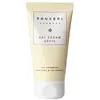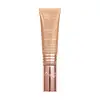What's inside
What's inside
 Key Ingredients
Key Ingredients

 Benefits
Benefits

 Concerns
Concerns

 Ingredients Side-by-side
Ingredients Side-by-side

Water
Skin ConditioningGlycerin
HumectantGlyceryl Stearate
EmollientGlycine Soja Oil
EmollientCetearyl Alcohol
EmollientOctocrylene
UV AbsorberPalmitic Acid
EmollientStearic Acid
CleansingPhenylbenzimidazole Sulfonic Acid
UV AbsorberButyrospermum Parkii Butter
Skin ConditioningButyl Methoxydibenzoylmethane
UV AbsorberIsopropyl Palmitate
EmollientCaprylic/Capric Triglyceride
MaskingPropylene Glycol
HumectantPhenoxyethanol
PreservativeDimethicone
EmollientPanthenol
Skin ConditioningTocopheryl Acetate
AntioxidantSodium Hyaluronate
HumectantLecithin
EmollientUbiquinone
AntioxidantSodium Polyacrylate
AbsorbentParaffinum Liquidum
EmollientAlcohol
AntimicrobialTetrasodium Iminodisuccinate
Trideceth-6
EmulsifyingEthylhexylglycerin
Skin ConditioningSodium Hydroxide
BufferingCitric Acid
BufferingWater, Glycerin, Glyceryl Stearate, Glycine Soja Oil, Cetearyl Alcohol, Octocrylene, Palmitic Acid, Stearic Acid, Phenylbenzimidazole Sulfonic Acid, Butyrospermum Parkii Butter, Butyl Methoxydibenzoylmethane, Isopropyl Palmitate, Caprylic/Capric Triglyceride, Propylene Glycol, Phenoxyethanol, Dimethicone, Panthenol, Tocopheryl Acetate, Sodium Hyaluronate, Lecithin, Ubiquinone, Sodium Polyacrylate, Paraffinum Liquidum, Alcohol, Tetrasodium Iminodisuccinate, Trideceth-6, Ethylhexylglycerin, Sodium Hydroxide, Citric Acid
Aloe Barbadensis Leaf Water
MaskingCyclopentasiloxane
EmollientDimethicone Crosspolymer
Emulsion StabilisingPhenyl Trimethicone
Skin ConditioningDihydroxyacetone
Skin ConditioningSynthetic Fluorphlogopite
Homosalate
Skin ConditioningEthylhexyl Methoxycinnamate
UV AbsorberCetearyl Alcohol
EmollientGlycerin
HumectantOctocrylene
UV AbsorberCetyl Alcohol
EmollientCeteareth-20
CleansingButyrospermum Parkii Butter
Skin ConditioningGlyceryl Stearate
EmollientIsohexadecane
EmollientIsododecane
EmollientNeopentyl Glycol Diheptanoate
EmollientTocopheryl Acetate
AntioxidantPanthenol
Skin ConditioningHyaluronic Acid
HumectantHydrolyzed Silk
HumectantTetrasodium Glutamate Diacetate
Citric Acid
BufferingPhenoxyethanol
PreservativeEthylhexylglycerin
Skin ConditioningTin Oxide
AbrasiveCI 77891
Cosmetic ColorantCI 77491
Cosmetic ColorantCI 77492
Cosmetic ColorantCI 77499
Cosmetic ColorantAloe Barbadensis Leaf Water, Cyclopentasiloxane, Dimethicone Crosspolymer, Phenyl Trimethicone, Dihydroxyacetone, Synthetic Fluorphlogopite, Homosalate, Ethylhexyl Methoxycinnamate, Cetearyl Alcohol, Glycerin, Octocrylene, Cetyl Alcohol, Ceteareth-20, Butyrospermum Parkii Butter, Glyceryl Stearate, Isohexadecane, Isododecane, Neopentyl Glycol Diheptanoate, Tocopheryl Acetate, Panthenol, Hyaluronic Acid, Hydrolyzed Silk, Tetrasodium Glutamate Diacetate, Citric Acid, Phenoxyethanol, Ethylhexylglycerin, Tin Oxide, CI 77891, CI 77491, CI 77492, CI 77499
Ingredients Explained
These ingredients are found in both products.
Ingredients higher up in an ingredient list are typically present in a larger amount.
This ingredient is also known as shea butter. It is an effective skin hydrator and emollient.
Emollients help soothe and soften your skin. It does this by creating a protective film on your skin. This barrier helps trap moisture and keeps your skin hydrated. Emollients may be effective at treating dry or itchy skin.
Shea butter is rich in antioxidants. Antioxidants help fight free-radicals, or molecules that may harm the body. It is also full of fatty acids including stearic acid and linoleic acid. These acids help replenish the skin and keep skin moisturized.
While Shea Butter has an SPF rating of about 3-4, it is not a sunscreen replacement.
Shea butter may not be fungal acne safe. We recommend speaking with a professional if you have any concerns.
Learn more about Butyrospermum Parkii ButterCetearyl alcohol is a mixture of two fatty alcohols: cetyl alcohol and stearyl alcohol. It is mainly used as an emulsifier. Emulsifiers help prevent the separation of oils and products. Due to its composition, it can also be used to thicken a product or help create foam.
Cetearyl alcohol is an emollient. Emollients help soothe and hydrate the skin by trapping moisture.
Studies show Cetearyl alcohol is non-toxic and non-irritating. The FDA allows products labeled "alcohol-free" to have fatty alcohols.
This ingredient is usually derived from plant oils such as palm, vegetable, or coconut oils. There is debate on whether this ingredient will cause acne.
Due to the fatty acid base, this ingredient may not be Malassezia folliculitis safe.
Learn more about Cetearyl AlcoholCitric Acid is an alpha hydroxy acid (AHA) naturally found in citrus fruits like oranges, lemons, and limes.
Like other AHAs, citric acid can exfoliate skin by breaking down the bonds that hold dead skin cells together. This helps reveal smoother and brighter skin underneath.
However, this exfoliating effect only happens at high concentrations (20%) which can be hard to find in cosmetic products.
Due to this, citric acid is usually included in small amounts as a pH adjuster. This helps keep products slightly more acidic and compatible with skin's natural pH.
In skincare formulas, citric acid can:
While it can provide some skin benefits, research shows lactic acid and glycolic acid are generally more effective and less irritating exfoliants.
Most citric acid used in skincare today is made by fermenting sugars (usually from molasses). This synthetic version is identical to the natural citrus form but easier to stabilize and use in formulations.
Read more about some other popular AHA's here:
Learn more about Citric AcidEthylhexylglycerin (we can't pronounce this either) is commonly used as a preservative and skin softener. It is derived from glyceryl.
You might see Ethylhexylglycerin often paired with other preservatives such as phenoxyethanol. Ethylhexylglycerin has been found to increase the effectiveness of these other preservatives.
Glycerin is already naturally found in your skin. It helps moisturize and protect your skin.
A study from 2016 found glycerin to be more effective as a humectant than AHAs and hyaluronic acid.
As a humectant, it helps the skin stay hydrated by pulling moisture to your skin. The low molecular weight of glycerin allows it to pull moisture into the deeper layers of your skin.
Hydrated skin improves your skin barrier; Your skin barrier helps protect against irritants and bacteria.
Glycerin has also been found to have antimicrobial and antiviral properties. Due to these properties, glycerin is often used in wound and burn treatments.
In cosmetics, glycerin is usually derived from plants such as soybean or palm. However, it can also be sourced from animals, such as tallow or animal fat.
This ingredient is organic, colorless, odorless, and non-toxic.
Glycerin is the name for this ingredient in American English. British English uses Glycerol/Glycerine.
Learn more about GlycerinGlyceryl Stearate is a mix of glycerin and stearic acid.
It is used to stabilize the mixing of water and oil ingredients. By preventing these ingredients from separating, it can help elongate shelf life. It can also help thicken the product's texture.
As an emollient, it helps soften skin and supports barrier-replenishing ingredients.
In cosmetics, Glyceryl Stearate is often made from vegetable oils or synthetically produced.
This ingredient may not be fungal-acne safe
Fun fact: The human body also creates Glyceryl Stearate naturally.
Learn more about Glyceryl StearateOctocrylene protects skin from sun damage. It absorbs UV-B with peak absorption of 304 nm. It is a common sunscreen ingredient and often paired with avobenzone, a UVA filter. This is because octocrylene stabilizes other sunscreen ingredients by protecting them from degradation when exposed to sunlight. Octocrylene is a photostable ingredient and loses about 10% of SPF in 95 minutes.
Octocrylene also acts as an emollient, meaning it helps skin retain moisture and softens skin. It is oil-soluble and hydrophobic, enhancing water-resistant properties in a product.
Those who are using ketoprofen, a topical anti-inflammatory drug, may experience an allergic reaction when using octocrylene. It is best to speak with a healthcare professional about using sunscreens with octocrylene.
The EU allows a maximum of these concentrations:
Learn more about OctocrylenePanthenol is a common ingredient that helps hydrate and soothe the skin. It is found naturally in our skin and hair.
There are two forms of panthenol: D and L.
D-panthenol is also known as dexpanthenol. Most cosmetics use dexpanthenol or a mixture of D and L-panthenol.
Panthenol is famous due to its ability to go deeper into the skin's layers. Using this ingredient has numerous pros (and no cons):
Like hyaluronic acid, panthenol is a humectant. Humectants are able to bind and hold large amounts of water to keep skin hydrated.
This ingredient works well for wound healing. It works by increasing tissue in the wound and helps close open wounds.
Once oxidized, panthenol converts to pantothenic acid. Panthothenic acid is found in all living cells.
This ingredient is also referred to as pro-vitamin B5.
Learn more about PanthenolPhenoxyethanol is a preservative that has germicide, antimicrobial, and aromatic properties. Studies show that phenoxyethanol can prevent microbial growth. By itself, it has a scent that is similar to that of a rose.
It's often used in formulations along with Caprylyl Glycol to preserve the shelf life of products.
Tocopheryl Acetate is AKA Vitamin E. It is an antioxidant and protects your skin from free radicals. Free radicals damage the skin by breaking down collagen.
One study found using Tocopheryl Acetate with Vitamin C decreased the number of sunburned cells.
Tocopheryl Acetate is commonly found in both skincare and dietary supplements.
Learn more about Tocopheryl Acetate